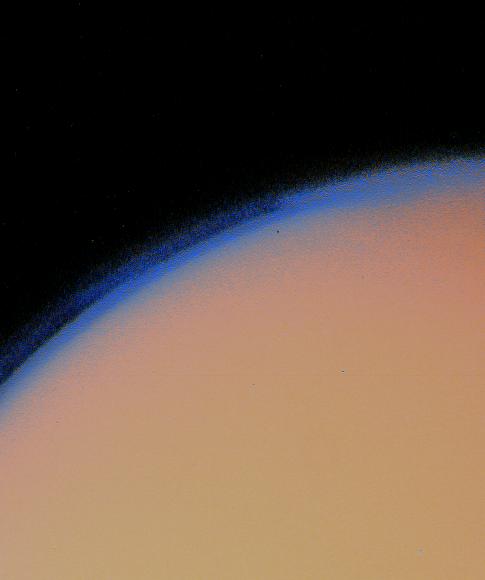TITAN (TEYE-tuhn)
The
largest moon of Saturn
Common clues: Saturn's largest moon;
Largest moon of Saturn; Satellite of Saturn; Moon of Saturn;
Saturn satellite; Saturn's largest satellite; A moon of
Saturn
Crossword
puzzle frequency:
3 times a year
Frequency
in English language:
26810 / 86800
News: NASA
plans to send an autonomous submarine to explore Titan's oceans
Video: Saturn's
Mysterious Moons
Titan (or Saturn VI) is the largest moon of Saturn. It is the only natural satellite known to have a dense atmosphere, and the only object other than Earth for which clear evidence of stable bodies of surface liquid has been found.

Voyager
1 view of haze on Titan's limb (1980)
Titan is the sixth ellipsoidal moon from Saturn. Frequently described as a planet-like moon, Titan has a diameter roughly 50% larger than the Moon and is 80% more massive. It is the second-largest moon in the Solar System, after Jupiter's moon Ganymede, and is larger by volume than the smallest planet, Mercury, although only about 41% as massive. Titan was the first known moon of Saturn, discovered in 1655 by the Dutch astronomer Christiaan Huygens, and was the fifth moon (not including the Moon) to be discovered.
Titan
is primarily composed of water ice and rocky material. Much as
with Venus prior to the Space Age, the dense, opaque atmosphere
prevented understanding of Titan's surface until new information
accumulated with the arrival of the Cassini–Huygens mission
in 2004, including the discovery of liquid hydrocarbon lakes in
the satellite's polar regions. The surface is geologically young;
although mountains and several possible cryovolcanoes have been
discovered, it is smooth and few impact craters have been found.
The atmosphere of Titan is largely composed of nitrogen; minor components lead to the formation of methane and ethane clouds and nitrogen-rich organic smog. The climate—including wind and rain—creates surface features similar to those of Earth, such as dunes, rivers, lakes and seas (probably of liquid methane and ethane), and deltas, and is dominated by seasonal weather patterns as on Earth. With its liquids (both surface and subsurface) and robust nitrogen atmosphere, Titan's methane cycle is viewed as an analog to Earth's water cycle, although at a much lower temperature.
This article is licensed under the GNU Free Documentation License. It uses material from the Wikipedia article "Titan".
|
|